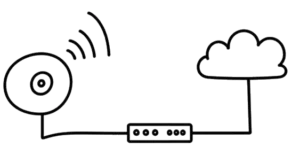Eventnet Support
Access point

What is an access point?
In a network, the access point ensures that devices such as smartphones, laptops or tablets can access the internet wirelessly, i.e. via WiFi. It acts as a bridge to the base device, the router, which then establishes the connection to the internet.
How does an access point work?
The access point sends out a WiFi signal that devices can connect to. As soon as a device, e.g. a smartphone, receives this signal and connects, the access point forwards the data to the router or the network. This allows all connected devices to access the internet or communicate with each other.
Difference between access point and router
An access point is often confused with a router. While a router establishes the connection to the Internet and distributes data in a network, an access point only provides the WiFi signal to make the Internet available wirelessly.
Areas of application for access points
- At home: In large houses or apartments to make WiFi available in all rooms.
- Companies: In offices, hotels or schools to give many people access to the Internet at the same time.
- Public places: In cafés, airports or parks to offer visitors WiFi .
An access point therefore ensures that you are always well connected, even in areas with a weak WiFi signal!
Difference between access points in the private sector and in the industrial sector
Access points are available in different versions, depending on where they are used: in the private sector (e.g. at home) or in the industrial sector (e.g. in companies, warehouses or large public facilities). Both types have the same basic principle - they provide WiFi - but there are some important differences.
Performance and range
Private area: Access points for the home are designed for smaller rooms and a limited number of devices. They usually only cover one house or apartment and are optimized to provide WiFi for a few devices at the same time (smartphones, tablets, laptops).
Industrial sector: Access points for companies or industrial plants need to cover larger areas, e.g. entire office buildings or warehouses. They offer a greater range and can handle many devices at the same time, often hundreds or more, without slowing down the network.
Robustness and design
Private sector: Appliances in the private sector are often smaller, more compact and intended for use in closed, dry rooms. They usually have a simple design that blends in well with a living room or study.
Industrial sector: Industrial access points are more robust, often waterproof and dustproof (IP-certified) and resistant to extreme temperatures. They are designed to work in demanding environments such as warehouses, factories or outdoors.
Range of functions
Private area: Access points for the home are generally easy to use and set up. They offer basic functions such as WiFi encryption and parental control, but no advanced management functions.
Industrial sector: Industrial access points offer a variety of advanced features. These include central management (to control many access points simultaneously), enterprise-level security features and traffic prioritization (Quality of Service, QoS) to prioritize certain applications such as video conferencing or VoIP.
Costs
Private sector: Access points for private use are generally cheaper as they are less complex and powerful.
Industrial sector: Industrial access points are more expensive as they have been specially developed for high performance, reliability and resilience.